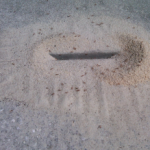As the name suggests pavement ants are so called because of their tendency to construct their nest under sidewalks, driveways and patios. Also known as stadium, piss, sugar, house or picnic ants they dot our pathways and landscapes with their somewhat circular mounds and one central entry hole. These small crater like entrances are similar in appearance but smaller than those of the pyramid ant. The colony can consist of thousands of workers and contains multiple queens. This ant feeds on just about anything and is very territorial. Large scale ‘sidewalk battles’ can often be viewed as rivals try to dominate the area and drive other colonies out. While day time activity is normal, this ant is even more active at night.

These ants often enter homes in search of food and quickly swarm pet dishes or scraps found on the floor. They easily find their way in through plumbing holes, small cracks and gaps or other such entries. Swarms do occur inside structures and at times can be very frustrating to deal with. If the conditions are not favorable only a relative few will emerge at a time prolonging this process sometimes for weeks.
How They Travel
Pavement ants inhabit many parts of the country including parts of California, Mid-West , Florida and other South Eastern States. This ant can swarm at almost any time of the year but primarily in the spring. Swarming numbers can be very large when conditions are favorable. With strong winds, mating ants can be carried quite some distance where they will begin to establish new colonies. While they do try and dominate an area the nest is usually in just one location so wide spread infestation is limited because when one colony has taken over an area it means another has been eliminated. This ant can be transported in shipping of goods such as landscaping materials. It is believed this ant was introduced to the United States via soil shipments in the 18th and 19th centuries.
How Best To Identify Pavement Ants
Pavement ants are fairly non de-script and their mounds can look very much like that of the pyramid ant but tends to be not as uniformly circular. This ant is very small-1/10 to 1/16th of an inch long and usually dark brown. Distinct ‘carved like’ lines can be seen on its head under magnification.
If your having troubles with these ants, please call us today to eliminate your headache. (352) 237-0122

Leave a Reply